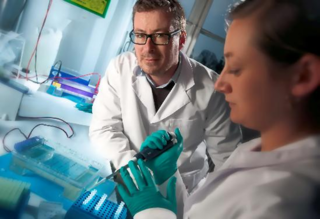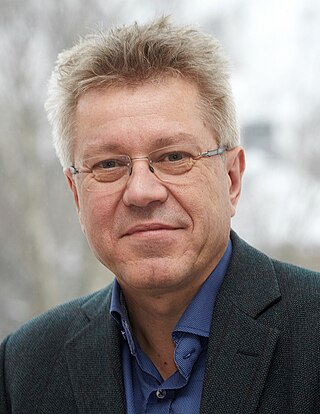Related Research Articles

In biological phylogenetics, a clade, also known as a monophyletic group or natural group, is a grouping of organisms that are monophyletic – that is, composed of a common ancestor and all its lineal descendants – on a phylogenetic tree. In the taxonomical literature, sometimes the Latin form cladus is used rather than the English form. Clades are the fundamental unit of cladistics, a modern approach to taxonomy adopted by most biological fields.

The University of Copenhagen is a public research university in Copenhagen, Denmark. Founded in 1479, the University of Copenhagen is the second-oldest university in Scandinavia after Uppsala University.

Evolutionary biology is the subfield of biology that studies the evolutionary processes that produced the diversity of life on Earth. It is also defined as the study of the history of life forms on Earth. Evolution holds that all species are related and gradually change over generations. In a population, the genetic variations affect the phenotypes of an organism. These changes in the phenotypes will be an advantage to some organisms, which will then be passed on to their offspring. Some examples of evolution in species over many generations are the peppered moth and flightless birds. In the 1930s, the discipline of evolutionary biology emerged through what Julian Huxley called the modern synthesis of understanding, from previously unrelated fields of biological research, such as genetics and ecology, systematics, and paleontology.

Eugene Viktorovich Koonin is a Russian-American biologist and Senior Investigator at the National Center for Biotechnology Information (NCBI). He is a recognised expert in the field of evolutionary and computational biology.
Eörs Szathmáry is a Hungarian theoretical evolutionary biologist at the now-defunct Collegium Budapest Institute for Advanced Study and at the Department of Plant Taxonomy and Ecology of Eötvös Loránd University, Budapest. He is the co-author with John Maynard Smith of The Major Transitions in Evolution, a seminal work which continues to contribute to ongoing issues in evolutionary biology. He is a member of the Batthyány Society of Professors.

The Faculty of Health and Medical Sciences at the University of Copenhagen houses 13 departments, 33 centres, five schools, four hospitals, and three libraries.
The oral polio vaccine (OPV) AIDS hypothesis is a now-discredited hypothesis that the AIDS pandemic originated from live polio vaccines prepared in chimpanzee tissue cultures, accidentally contaminated with simian immunodeficiency virus and then administered to up to one million Africans between 1957 and 1960 in experimental mass vaccination campaigns.

Martin Andreas Nowak is an Austrian-born professor of mathematics and biology at Harvard University. He is one of the leading researchers in evolutionary dynamics. Nowak has made contributions to the fields of evolutionary theory, cooperation, viral dynamics, and cancer dynamics.

Rigshospitalet is the largest public and teaching hospital in Copenhagen and the most highly specialised hospital in Denmark. The hospital's main building is a 16-storey functionalist highrise, one of the tallest structures in the central parts of the city. Rigshospitalet neighbours the Panum Building which houses the Faculty of Health and Medical Sciences at the University of Copenhagen. As a teaching hospital it is part of the framework organisation Copenhagen University Hospital.

Eske Willerslev is a Danish evolutionary geneticist notable for his pioneering work in molecular anthropology, palaeontology, and ecology. He currently holds the Prince Philip Professorship in Ecology and Evolution at University of Cambridge, UK and the Lundbeck Foundation Professorship in Evolution at Copenhagen University, Denmark. He is director of the Centre of Excellence in GeoGenetics, a research associate at the Wellcome Trust Sanger Institute, and a professorial fellow at St John's College, Cambridge. Willerslev is a foreign associate of the National Academy of Sciences (US) and holds the Order of the Dannebrog issued by her Majesty Queen Margrethe II of Denmark in 2017.
The Centre for Geogenetics is a Danish Basic Research Centre of Excellence (Grundforskningscenter) which officially opened in September 2010. It is located at the Natural History Museum of Denmark, University of Copenhagen and financed by the Danish National Research Foundation.
Jacobus Jan "Koos" Boomsma is a Dutch evolutionary biologist who studies social evolution and the evolution of mating systems.
The Extended Evolutionary Synthesis (EES) consists of a set of theoretical concepts argued to be more comprehensive than the earlier modern synthesis of evolutionary biology that took place between 1918 and 1942. The extended evolutionary synthesis was called for in the 1950s by C. H. Waddington, argued for on the basis of punctuated equilibrium by Stephen Jay Gould and Niles Eldredge in the 1980s, and was reconceptualized in 2007 by Massimo Pigliucci and Gerd B. Müller.
Scott Frederick Gilbert is an American evolutionary developmental biologist and historian of biology.
Soren Løvtrup (1922–2002) was a Danish embryologist and historian of science in the Department of Animal Physiology at the Umeå University, Sweden. Løvtrup was known for his macromutation theory of evolution, which was in opposition to traditional neo-Darwinism. In 1987, Løvtrup published his controversial book Darwinism: The Refutation of a Myth which challenged Charles Darwin's role as the intellectual founder of evolutionary theory and accused Darwin of plagiarism.
Rubina Raja is a classical archaeologist educated at University of Copenhagen (Denmark), La Sapienza University (Rome) and University of Oxford (England). She is professor (chair) of classical archaeology at Aarhus University and centre director of the Danish National Research Foundation's Centre of Excellence for Urban Network Evolutions (UrbNet). She specialises in the cultural, social and religious archaeology and history of past societies. Research foci include urban development and network studies, architecture and urban planning, the materiality of religion as well as iconography from the Hellenistic to Early Medieval periods. Her publications include articles, edited volumes and monographs on historiography, ancient portraiture and urban archaeology as well as themes in the intersecting fields between humanities and natural sciences. Rubina Raja received her DPhil degree from the University of Oxford in 2005 with a thesis on urban development and regional identities in the eastern Roman provinces under the supervision of Professors R.R.R. Smith and Margareta Steinby. Thereafter, she held a post-doctoral position at Hamburg University, Germany, before she in 2007 moved to a second post-doctoral position at Aarhus University, Denmark. In 2011–2016, she was a member of the Young Academy of Denmark, where she was elected chairwoman in 2013.

Ole Kiehn is a Danish-Swedish neuroscientist. He is Professor of Integrative Neuroscience at the Department of Neuroscience, University of Copenhagen, Denmark, and professor of neurophysiology at Karolinska Institute, Sweden.
Henrik Gottlieb is a Danish linguist and translation scholar, who is most known for his work in audiovisual translation. He is an associate professor emeritus at the University of Copenhagen.
Michael Worobey is a Canadian evolutionary biologist, and a professor and department head of Ecology and Evolutionary Biology at the University of Arizona. He has done important work in the study of the evolution of HIV-1, which demonstrated the extensive genetic diversity of the virus by 1960, fully refuting the contaminated polio vaccine theory as the origin of the AIDS pandemic.
Elisabeth Engberg-Pedersen is a Danish linguist and professor of applied linguistics at the University of Copenhagen. She has contributed significantly to the description of Danish Sign Language and was the only sign language linguist in Denmark from 1978 to 2004. She is considered an important figure in the development of Danish functional linguistics, and has also studied autism and the relation between language and cognition from a cognitive-functional perspective with focus on semantics and pragmatics. She is the sister of Troels Engberg-Pedersen.
References
- ↑ "Highly Cited Researchers (h>100) according to their Google Scholar Citations public profiles". Ranking Web of Universities. Consejo Superior de Investigaciones Científicas. Retrieved 5 January 2022.
- ↑ "Center For Evolutionary Hologenomics (CEH)". Danish National Research Foundation. Retrieved 5 January 2022.
- ↑ Gilbert, M. Thomas P.; Rambaut, Andrew; Wlasiuk, Gabriela; Spira, Thomas J.; Pitchenik, Arthur E.; Worobey, Michael (20 November 2007). "The emergence of HIV/AIDS in the Americas and beyond". Proceedings of the National Academy of Sciences. 104 (47): 18566–18570. doi: 10.1073/pnas.0705329104 . PMC 2141817 . PMID 17978186.
- ↑ Worobey, Michael; Gemmel, Marlea; Teuwen, Dirk E.; Haselkorn, Tamara; Kunstman, Kevin; Bunce, Michael; Muyembe, Jean-Jacques; Kabongo, Jean-Marie M.; Kalengayi, Raphaël M.; Van Marck, Eric; Gilbert, M. Thomas P.; Wolinsky, Steven M. (October 2008). "Direct evidence of extensive diversity of HIV-1 in Kinshasa by 1960". Nature. 455 (7213): 661–664. Bibcode:2008Natur.455..661W. doi:10.1038/nature07390. PMC 3682493 . PMID 18833279.
- ↑ "Editorial Board". Evolution, Medicine and Public Health. Oxford Academic. Retrieved 5 January 2022.
- ↑ "Editorial Board". besjournals. Retrieved 5 January 2022.
- ↑ "Editorial Board: Current Biology". www.cell.com. Retrieved 25 April 2019.
- ↑ "Royal Academy". www.royalacademy.dk. Retrieved 5 January 2022.